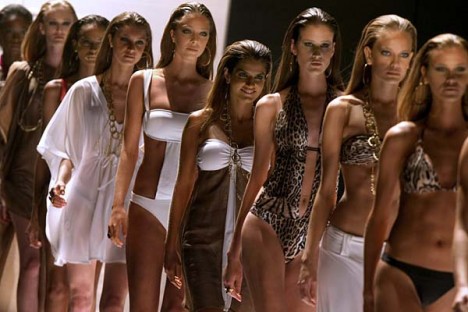Brazil’s prosperity bursts forth on catwalk
Brazil kicked off Latin America’s premier fashion event, Sao Paulo Fashion Week, Wednesday, with parades showcasing its economic prosperity and optimism. “We’re a young country, a young culture, with an enormous potential for growth, for development,” organizer Paulo Borges told reporters ahead of the first shows. Brazil‘s designs for the 2010-2011 summer season — including […]

Brazil kicked off Latin America’s premier fashion event, Sao Paulo Fashion Week, Wednesday, with parades showcasing its economic prosperity and optimism.
“We’re a young country, a young culture, with an enormous potential for growth, for development,” organizer Paulo Borges told reporters ahead of the first shows.
Brazil‘s designs for the 2010-2011 summer season — including the inevitable sexy bikinis — are sashaying down the catwalks daily to next Monday under the overarching theme “Anima” (“animated” or “lively” in Portuguese).
Gisele Bundchen, the Brazilian beauty who has become the world’s top-paid model, will Sunday be making her first catwalk show since giving birth to a baby four months ago with her husband, US football player Tom Brady.
The Sao Paulo Fashion Week this year trains the spotlight on Brazilians’ obsession with brand names and stylish clothes, underpinning a 50-billion-dollar fashion market that is becoming one of the most profitable in the world for the big luxury groups.
It also confirms Brazil’s growing economic power.
Latin America’s biggest economy, ranked 10th in the world, is currently expanding at nine percent on an annual basis — almost as much as the global champion China.
A leading consulting firm specializing in Brazil’s luxury market, MCF Consultoria, said the sector expanded 11.5 percent last year, when much of the rest of the world was tightening its belts in the global downturn, and could grow more than 17 percent this year.
“Brazilians love to shop,” the firm’s director, Carlos Ferreirinha, told AFP.
“In Brazil, people will spend what they do not have. Spending in Brazil is much higher than any discretionary money capability,” he said.
He explained that shops regularly allow customers to pay off items in monthly instalments, interest free.
That, and the soaring value of Brazil’s currency, the real, have pushed spending on imported goods denominated in dollars or euros to a record level.
French label Louis Vuitton, whose handbags grace the arm of almost every woman in Sao Paulo’s rich Jardins neighborhood, has done very well from the trend, winning brand-recognition with 23 percent of Brazilian consumers, according to a survey conducted by MCF Consultoria.
Giorgio Armani, Chanel, Dior and Gucci also have big profiles.
Brazilians are fashion snobs, insisting on wearing the very latest collections from Europe, Ferreirinha explained.
“They want to give the impression that they are very updated, very contemporary, and this is translated into impulsiveness,” he said.
And there no immediate prospect of Brazil’s gaping consumerist maw snapping shut any time soon, according to Ferreirinha.
“We’re going to have at least 20 years more of very important growth. Brazil is still very much behind the development process that everybody believes we can have,” he said, pointing to a nascent but rapidly growing middle class.
Source: AFPrelaxnews







